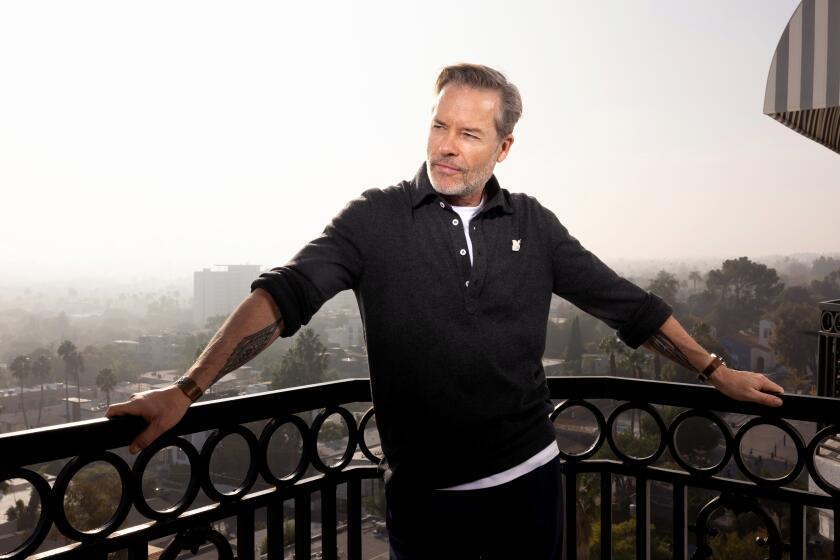
The score for “The Brutalist” is itself a feat of architectural engineering.
Composing only his second feature film, Daniel Blumberg gathered solos, performances and improvisations from select instrumentalists all over Europe — from the garden studio of an octogenarian pianist on the southern coast of England, to a posh studio in Paris, to musicians’ flats and kitchens in Berlin and elsewhere — and assembled them into an imposing cathedral of sound that matches the scale of Brady Corbet’s VistaVision epic.
Tracking Adrien Brody’s Hungarian architect (the fictional László Tóth) from his arrival at Ellis Island sometime after World War II, Blumberg’s score asserts itself immediately with the musical thrum of construction — achieved with a hammerlike rhythm on prepared piano — and the churning, chaotic sound of industry by way of a warmly masculine brass anthem and all kinds of clacks, saws and snarls from his ragtag “orchestra.”
Edward Berger, Brady Corbet, Coralie Fargeat, James Mangold, Denis Villeneuve and Malcolm Washington on adapting as you go, feminism in film — and vaping in the Sistine Chapel.
“Brady always talked about this collage aspect,” says Blumberg, referring to the film’s mix of 35mm and digital formats with archival footage. The musician’s own instincts already leaned that way, and when he started thinking about the score, “It’s not like, ‘Oh, I want the trumpet on this.’ It’s like, ‘Axel Dörner would be perfect for this,’” he says of the trumpet master he recorded in Berlin.
The composer assembled a dream team of musicians, many of whom were already friends or mutual friends — or, in the case of 88-year-old John Tilbury, a longtime hero. Blumberg took his portable recording equipment to them partly out of necessity; Tilbury doesn’t travel, and Sophie Agnel, another accomplished pianist, had restrictions on her busy schedule. But this also led to more free-form experimentation where the musicians could really express themselves.
And even the space itself became part of the music. It was pouring rain one day on the roof of Tilbury’s kitchen shed, which caused Blumberg to worry. The pianist said: “I can do a duo with the rain.” Blumberg said: “I know — I’ve got your record where you do a duo with the dust.” “But in the end,” Blumberg says, “it was just beautiful, and we used it.”

(That “duo” is best heard in the scene where Tóth and his crew build a library for Guy Pearce’s character, Harrison Lee Van Buren.)
Blumberg is a somewhat shy, 34-year-old singer and multi-instrumentalist from London who, for the last two decades, has recorded albums in various bands and as a solo artist, and whose only ostensible throughline is raw emotion and sonic experimentation. He met the American Corbet 10 years ago when the former actor was working on his directorial debut, “The Childhood of a Leader.” They hit it off instantly — Corbet stayed on Blumberg’s sofa the first night they met — and every time Blumberg finished a new record, he would discuss it with Corbet.
Even before scoring his first film, “The World to Come,” in 2020 (directed by Mona Fastvold, Corbet’s partner), Blumberg was expecting to score Corbet’s ambitious throwback opus. They began discussing it years ago in its initial preproduction stage before the pandemic, when the project was temporarily scuttled and recast. The score was under construction before and alongside the picture, and Corbet always said he wanted to shoot some of his movie to the music.
The piece that underscores Tóth’s chaotic opening moments, from below deck of a ship to his sight of an upside-down Statue of Liberty, was actually a demo that Blumberg made in his London flat. Corbet amplified the track on set, and cinematographer Lol Crawley was “kind of moving with the music,” explains Blumberg, “and the choreography of Adrien and the extras. They were all moving like a kind of dance.” (Blumberg later improved the track with his virtuoso musicians.)
The sound of searching was baked into the score. Blumberg doesn’t read or write music, so “I’m always just sort of bashing away, trying to find chords,” he says. “Brady heard me in my room doing that, and he came in and he was like, ‘I mean, that’s literally the sound of someone working something out. That’s what we want to try and retain.’”
The veteran actor, known for “Memento,” “L.A. Confidential” and HBO’s “Mildred Pierce,” has been earning praise for his complex portrayal of an enigmatic industrialist.
“A lot of the temp was done to these kind of weird recordings,” Blumberg says with a laugh, “where I’m, like, dropping my vape on the floor.”
To retain that spirit, he put a microphone on Tilbury himself, to capture the sound of the pianist adjusting in his chair or breathing; if you listen closely during the film’s intermission, you can actually hear Tilbury scribbling on his sheet music.
Both the film and its score achieved remarkable scope and weight out of relatively thin resources — there are no strings on the score — but perhaps the greatest length Blumberg went to was traveling to Carrara, Italy, where the scenes in its famous marble quarry had already been shot. He recorded the quarry’s unique impulse response (achieved by firing a gun), then applied that reverb onto a recording of his saxophone player, Evan Parker, which had been made in an office in Kent, England.
“We put Kent in Carrera,” says Blumberg — aptly summarizing his strange and towering achievement.
More to Read
From the Oscars to the Emmys.
Get the Envelope newsletter for exclusive awards season coverage, behind-the-scenes stories from the Envelope podcast and columnist Glenn Whipp’s must-read analysis.
You may occasionally receive promotional content from the Los Angeles Times.












